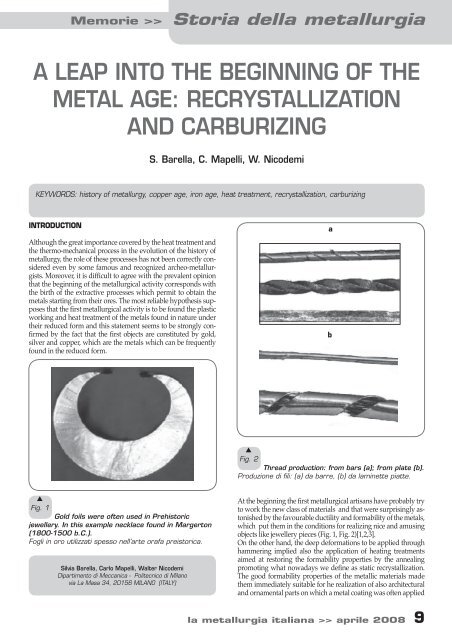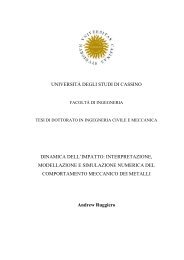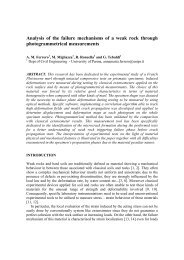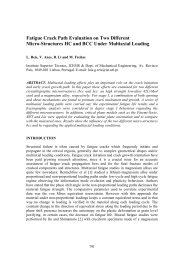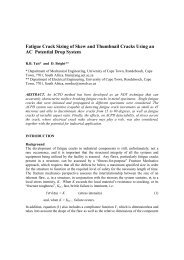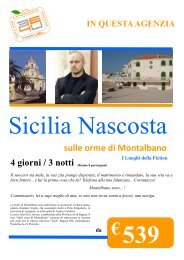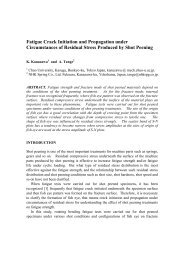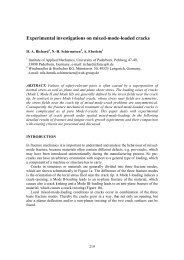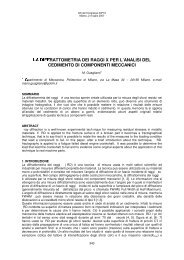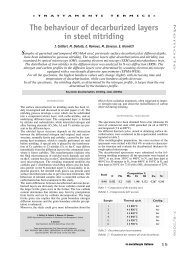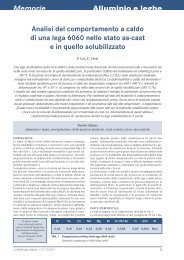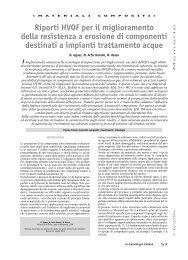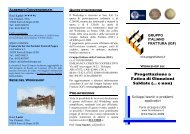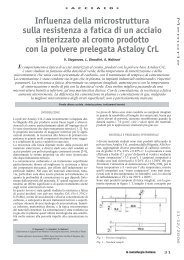a leap into the beginning of the metal - Gruppo Italiano Frattura
a leap into the beginning of the metal - Gruppo Italiano Frattura
a leap into the beginning of the metal - Gruppo Italiano Frattura
Create successful ePaper yourself
Turn your PDF publications into a flip-book with our unique Google optimized e-Paper software.
Memorie >><br />
Storia della <strong>metal</strong>lurgia<br />
A LEAP INTO THE BEGINNING OF THE<br />
METAL AGE: RECRYSTALLIZATION<br />
AND CARBURIZING<br />
S. Barella, C. Mapelli, W. Nicodemi<br />
KEYWORDS: history <strong>of</strong> <strong>metal</strong>lurgy, copper age, iron age, heat treatment, recrystallization, carburizing<br />
INTRODUCTION<br />
Although <strong>the</strong> great importance covered by <strong>the</strong> heat treatment and<br />
<strong>the</strong> <strong>the</strong>rmo-mechanical process in <strong>the</strong> evolution <strong>of</strong> <strong>the</strong> history <strong>of</strong><br />
<strong>metal</strong>lurgy, <strong>the</strong> role <strong>of</strong> <strong>the</strong>se processes has not been correctly considered<br />
even by some famous and recognized archeo-<strong>metal</strong>lurgists.<br />
Moreover, it is difficult to agree with <strong>the</strong> prevalent opinion<br />
that <strong>the</strong> <strong>beginning</strong> <strong>of</strong> <strong>the</strong> <strong>metal</strong>lurgical activity corresponds with<br />
<strong>the</strong> birth <strong>of</strong> <strong>the</strong> extractive processes which permit to obtain <strong>the</strong><br />
<strong>metal</strong>s starting from <strong>the</strong>ir ores. The most reliable hypo<strong>the</strong>sis supposes<br />
that <strong>the</strong> first <strong>metal</strong>lurgical activity is to be found <strong>the</strong> plastic<br />
working and heat treatment <strong>of</strong> <strong>the</strong> <strong>metal</strong>s found in nature under<br />
<strong>the</strong>ir reduced form and this statement seems to be strongly confirmed<br />
by <strong>the</strong> fact that <strong>the</strong> first objects are constituted by gold,<br />
silver and copper, which are <strong>the</strong> <strong>metal</strong>s which can be frequently<br />
found in <strong>the</strong> reduced form.<br />
s<br />
Fig. 1<br />
Gold foils were <strong>of</strong>ten used in Prehistoric<br />
jewellery. In this example necklace found in Margerton<br />
(1800-1500 b.C.).<br />
Fogli in oro utilizzati spesso nell’arte orafa preistorica.<br />
Silvia Barella, Carlo Mapelli, Walter Nicodemi<br />
Dipartimento di Meccanica - Politecnico di Milano<br />
via La Masa 34, 20156 MILANO (ITALY)<br />
s<br />
Fig. 2<br />
Thread production: from bars (a); from plate (b).<br />
Produzione di fili: (a) da barre, (b) da laminette piatte.<br />
At <strong>the</strong> <strong>beginning</strong> <strong>the</strong> first <strong>metal</strong>lurgical artisans have probably try<br />
to work <strong>the</strong> new class <strong>of</strong> materials and that were surprisingly astonished<br />
by <strong>the</strong> favourable ductility and formability <strong>of</strong> <strong>the</strong> <strong>metal</strong>s,<br />
which put <strong>the</strong>m in <strong>the</strong> conditions for realizing nice and amusing<br />
objects like jewellery pieces (Fig. 1, Fig. 2)[1,2,3].<br />
On <strong>the</strong> o<strong>the</strong>r hand, <strong>the</strong> deep deformations to be applied through<br />
hammering implied also <strong>the</strong> application <strong>of</strong> heating treatments<br />
aimed at restoring <strong>the</strong> formability properties by <strong>the</strong> annealing<br />
promoting what nowadays we define as static recrystallization.<br />
The good formability properties <strong>of</strong> <strong>the</strong> <strong>metal</strong>lic materials made<br />
<strong>the</strong>m immediately suitable for he realization <strong>of</strong> also architectural<br />
and ornamental parts on which a <strong>metal</strong> coating was <strong>of</strong>ten applied<br />
la <strong>metal</strong>lurgia italiana >> aprile 2008 9<br />
a<br />
b
Storia della <strong>metal</strong>lurgia
Memorie >><br />
s<br />
Fig. 6<br />
Ancient nail (a) from <strong>the</strong> roman legionary at<br />
Inchtuthil (Wales, 83 a.C.) and its particular composite<br />
structure (b).<br />
Esempio di antico chiodo romano proveniente da<br />
Inchtuthil (83 a.C.).<br />
s<br />
Fig. 8<br />
Influence <strong>of</strong> annealing on work hardened<br />
copper. The pure copper recrystallization temperature<br />
is about 220°C.<br />
Influenza del processo di ricottura sulle proprietà<br />
di resistenza e duttilità del rame precedentemente<br />
incrudito.<br />
recrystallization, whose energy <strong>of</strong> activation can be overcome by<br />
<strong>the</strong> temperature field which can be reached during <strong>the</strong> Neolythic<br />
Age (Fig. 8). The recrystallization is a phenomenon <strong>of</strong> nucleation<br />
and growth <strong>of</strong> new grains which consume <strong>the</strong> previous deformed<br />
one, recreating s<strong>of</strong>t unstrained crystallites.<br />
The plastic deformation and <strong>the</strong> related phenomena and processes<br />
are at <strong>the</strong> basis <strong>of</strong> <strong>the</strong> working operation which follows under <strong>the</strong><br />
name <strong>of</strong> sphyrèlaton (σϕυρηλατον-worked by hammer), a technique<br />
typically applied in <strong>the</strong> first statuary art, but also for coating<br />
buildings and ships. This technique consists in <strong>the</strong> coating <strong>of</strong> a<br />
wood or marble core by a thin <strong>metal</strong> layer applied by hammering<br />
and fixed by rivets (Fig. 9) [11].<br />
Although <strong>the</strong> recrystallization takes place, <strong>the</strong> microstructure<br />
formed after <strong>the</strong> annealing goes on to be featured by <strong>the</strong> traces <strong>of</strong><br />
<strong>the</strong> induced plastic deformation. Actually, even if <strong>the</strong> hardening<br />
due to sliding and twinning deformation is nearly eliminated, <strong>the</strong><br />
orientation <strong>of</strong> <strong>the</strong> new generated grains are affected by rotations<br />
undergone by <strong>the</strong> deformed crystallites (Fig.10) [12,13,14].<br />
The crystallite rotate in <strong>the</strong> space and displace <strong>the</strong>mselves following<br />
peculiar orientation; this issue appears as particularly clear in<br />
Storia della <strong>metal</strong>lurgia<br />
s<br />
Fig. 7<br />
VCopper in <strong>the</strong> native state (SEM micrographs).<br />
Aspetto del rame nativo osservato mediante SEM.<br />
s<br />
Fig. 9<br />
Example <strong>of</strong> sphyrèlaton. Separate foils are applied<br />
on <strong>the</strong> mold (a), <strong>the</strong>n <strong>the</strong>y are hammer (b), until <strong>the</strong> mold are<br />
completely covered (c) foils are fixed by rivet (d); bull found in<br />
Tell el Obeid (III millennio b.C.) realized by sphyrèlaton.<br />
Stadi del processo di realizzazione di uno sphyrèlaton<br />
(σϕυρηλατον-lavorato al martello). (a) Fogli separati vengono<br />
preparati per essere avvolti su un’anima in legno o in pietra (b) e<br />
successivamente vengono fatti aderire attraverso martellatura.<br />
(c) Le lamine di copertura vengono ribattute sino a che l’anima<br />
viene completamente rivestita (d) e successivamente vengono<br />
fissate attraverso l’applicazione dei rivetti.<br />
la <strong>metal</strong>lurgia italiana >> aprile 2008 11
Storia della <strong>metal</strong>lurgia
Memorie >><br />
s<br />
Fig. 12<br />
Crystallographic texture detected on a axe<br />
found in n.78 Remendello tomb [Autor: Gilberto Artioli<br />
- Università degli Studi di Padova].<br />
Tessiture cristallografiche osservate sull’ascia ritrovata<br />
nella tomba n.78 di Remedello (Autore: G. Artioli<br />
dell’Università degli Studi di Padova).<br />
realize a wider range <strong>of</strong> products to improve <strong>the</strong> quality and <strong>the</strong><br />
efficiency <strong>of</strong> <strong>the</strong> tools and <strong>of</strong> <strong>the</strong> shipping device permitting an<br />
intensification <strong>of</strong> trading across <strong>the</strong> Mediterranean Sea. Phoenicians<br />
and Greeks took important advantage from <strong>the</strong> described<br />
technological innovation.<br />
The increase <strong>of</strong> <strong>the</strong> efficiency in <strong>the</strong> steel objects realized between<br />
XI-X b.C. is proved by <strong>the</strong> rapid substitution <strong>of</strong> <strong>the</strong> bronze for <strong>the</strong><br />
realization <strong>of</strong> several objects [18].<br />
EXAMINATIONS ON DIFFERENT BLADES<br />
The blades, probably represent one <strong>of</strong> <strong>the</strong> most interesting typology<br />
<strong>of</strong> products for <strong>the</strong> evaluation <strong>of</strong> <strong>the</strong> evolution <strong>of</strong> <strong>the</strong> <strong>metal</strong>lurgical<br />
technique, because <strong>of</strong> <strong>the</strong> required combination <strong>of</strong> properties<br />
(strength-thoughness-hardness). Especially <strong>the</strong> blades <strong>of</strong> <strong>the</strong> axes<br />
and <strong>the</strong> ones <strong>of</strong> <strong>the</strong> sword are heavily loaded also in <strong>the</strong> impulsive<br />
modality.<br />
The investigation performed on <strong>the</strong> <strong>the</strong>rmo-mechanical properties<br />
performed on copper axes belonging to <strong>the</strong> Eneolitic Age can a<br />
be significant clue to understand <strong>the</strong> role played by <strong>the</strong> <strong>the</strong>rmomechanical<br />
properties on <strong>the</strong> designing <strong>of</strong> such a type <strong>of</strong> working<br />
tools. The neutronic diffraction performed by G. Artioli [19]<br />
has allowed to point out <strong>the</strong> texture developed also at <strong>the</strong> core <strong>of</strong><br />
<strong>the</strong> axes without implementing any destructive procedure. Some<br />
prehistoric axes going back between 3200b.C. and 1900b.C., have<br />
been analysed and show a crystallographic texture certainly induced<br />
through cold forming and only in some cases clear recrystallization<br />
textures have been recognized.<br />
The core <strong>of</strong> axe belonging to <strong>the</strong> Similaun man (3200b.C.) and <strong>the</strong><br />
axe <strong>of</strong> Kolmann, do not point out any particular intense texture<br />
probably for <strong>the</strong> presence <strong>of</strong> an equiaxed grain structure formed<br />
only by casting and solidification without <strong>the</strong> application <strong>of</strong> significant<br />
successive plastic deformation. Actually, <strong>the</strong> very weak<br />
texture indication seems to make reliable <strong>the</strong> hypo<strong>the</strong>sis <strong>of</strong> a static<br />
recrystallization following <strong>the</strong> application <strong>of</strong> a only slight plastic<br />
reduction (5-10%) probably aimed at restoring <strong>the</strong> shape and functionality<br />
<strong>of</strong> <strong>the</strong> tool after a certain working period.<br />
A clear presence <strong>of</strong> texture components {001} (Rotated Cube)<br />
and {001} (Cube) in <strong>the</strong> axes coming from tombs n.78 and 62<br />
at Remedello suggests that <strong>the</strong> realization <strong>of</strong> a <strong>the</strong>rmal treatment<br />
led <strong>the</strong> crystallite <strong>of</strong> <strong>the</strong> axes to orientate <strong>the</strong>mselves along <strong>the</strong> Ro-<br />
Storia della <strong>metal</strong>lurgia<br />
s<br />
Fig. 13<br />
Crystallographic texture detected on a axe<br />
found in n.62 Remendello tomb [Autor: Gilberto Artioli<br />
- Università degli Studi di Padova].<br />
Tessiture cristallografiche osservate sull’ascia ritrovata<br />
nella tomba n.62 di Remedello (Autore: G. Artioli<br />
dell’Università degli Studi di Padova).<br />
tated Cube component (Fig. 12, Fig. 13).<br />
It is extremely significant that <strong>the</strong> most sharp texture components<br />
belongs to <strong>the</strong> axes going back to <strong>the</strong> Copper Age. Actually, this<br />
texture needs <strong>the</strong> imposition <strong>of</strong> a high <strong>the</strong>rmal level applied for<br />
long time which could be reached only by <strong>the</strong> efficient refractories<br />
and combustion technique which are not typical <strong>of</strong> <strong>the</strong> first steps<br />
<strong>of</strong> Copper Age.<br />
O<strong>the</strong>r samples - nearly contemporary to <strong>the</strong> Remedello ones – usually<br />
show texture developed by textural features produced by an<br />
annealing treatment which has produced incomplete recrystallization:<br />
{211} (Copper), {321} (S), {110} (Brass),<br />
{110}(Goss) <strong>of</strong>ten organized along á-fiber, â-fiber and ã-fiber<br />
(Fig. 14, Fig. 15, Fig. 16).<br />
It is possible that <strong>the</strong> partial recrystallization was due to <strong>the</strong> attempt<br />
to modulate <strong>the</strong> mechanical properties <strong>of</strong> <strong>the</strong> axes through<br />
a compromise between <strong>the</strong> hardening featuring <strong>the</strong> plastically<br />
strained crystallite and <strong>the</strong> s<strong>of</strong>tening undergone by <strong>the</strong> recrystallized<br />
grains. The axes certainly represent a good example <strong>of</strong> <strong>the</strong><br />
<strong>the</strong>rmo-mechanical treatment applied to a mono-phase alloy in order<br />
to impose a particular combination <strong>of</strong> mechanical properties.<br />
s<br />
Fig. 14<br />
Crystallographic texture detected on Ponte<br />
Enza axe (11.6x4.9x1.1 cm3) [Autor: Gilberto Artioli -<br />
Università degli Studi di Padova].<br />
Tessiture cristallografiche osservate sull’ascia ritrovata in<br />
una tomba di Ponte Enza (11.6x4.9x1.1 cm3) (Autore:<br />
G. Artioli dell’Università degli Studi di Padova).<br />
la <strong>metal</strong>lurgia italiana >> aprile 2008 13
Storia della <strong>metal</strong>lurgia
Memorie >><br />
promoted welding realized during <strong>the</strong> forging <strong>of</strong> <strong>the</strong> different layers.<br />
The different layers during <strong>the</strong> forging and welding treatment<br />
were covered by a fluid fayalite slag saturated by FeO in order<br />
to protect <strong>the</strong> surface to be welded from <strong>the</strong> oxidation. In both<br />
<strong>the</strong> blades a strong formation <strong>of</strong> textures featured by {111} planes<br />
perpendicular to <strong>the</strong> blade line has been pointed out and this crystallographic<br />
situation certainly leads to a simultaneous increase <strong>of</strong><br />
resistance properties and <strong>of</strong> <strong>the</strong> thoughness. This favourable mix<br />
<strong>of</strong> properties certainly has been reached, although <strong>the</strong> contextual<br />
presence <strong>of</strong> such detrimental crystallographic components i.e. {<br />
13}, especially in sword from Vetulonia. However, <strong>the</strong> revealed<br />
component could be developed only through straining at high<br />
temperature in <strong>the</strong> austenitic phase and by <strong>the</strong> austenite-ferrite<br />
phase transformation before <strong>the</strong> recrystallization <strong>of</strong> austenite. Actually,<br />
in <strong>the</strong> sword from Chius <strong>the</strong> cooling rate was fast enough to<br />
cause <strong>the</strong> formation <strong>of</strong> acicular ferrite which can improve <strong>the</strong> yield<br />
strength <strong>of</strong> <strong>the</strong> blade (Fig. 18).<br />
The high concentration <strong>of</strong> misorientation angles toward <strong>the</strong> high-<br />
s<br />
Fig. 19<br />
Misorientation distribution in <strong>the</strong> Chiusi sword.<br />
Distribuzione della misorientazione osservata nella spada<br />
di Chiusi.<br />
s<br />
Fig. 20<br />
Misorientation distribution in <strong>the</strong> Vetulonia sword.<br />
Distribuzione della misorientazione osservata nella spada<br />
di Vetulonia.<br />
Storia della <strong>metal</strong>lurgia<br />
s<br />
Fig. 21<br />
Neumann lines detected on Vetulonia sword.<br />
Linee di Neumann osservate nella spada di Vetulonia.<br />
s<br />
Fig. 22<br />
Neumann lines detected on Chiusi sword (a);<br />
EBSD analysis underline twins (b).<br />
(a) Linee di Neumann rilevate nella spada di Chiusi e (b)<br />
fenomeni di geminazione evidenziati dall’analisi EBSD.<br />
la <strong>metal</strong>lurgia italiana >> aprile 2008 15<br />
a<br />
b
Storia della <strong>metal</strong>lurgia


